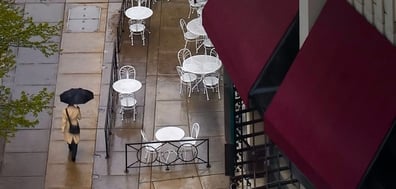
Millennials tend to look for restaurants that serve eco-friendly, organic, and local food. They also love to eat out, going to restaurants 14% more than their parents’ generation. That trend might be changing, however, thanks in part to the proliferation of healthy meal kit delivery services which make it easier to cook at home.
Restaurants will need to adapt in order to remain appealing to millennial audiences. One way restaurants can get their attention is to take their commitment to sustainability beyond food, and begin implementing eco-friendly design to limit energy consumption.
Here are some simple ideas architects, designers, and restaurant owners can use to support sustainability and keep their patrons coming.
Windows are a Clear Choice
Incorporating lots of glass into a restaurant design can help make a dining room feel open, airy, and welcoming. But windows do a lot more than create atmosphere. According to Energy Star, lighting, cooling, and refrigeration are the top three reasons restaurants use so much electricity (up to 10 times more than other commercial buildings). The right choice of windows can help reduce energy consumption in two of these three categories.
Big, clear, clean windows let in a lot of natural light, reducing the need for lamps and overhead fixtures. Imagine how much energy a restaurant could save if they didn’t need to turn on the lights during daylight hours.
Choosing the right windows makes a real difference. Cheap windows, or windows that have been installed incorrectly, can leak a lot of heat in and out of buildings, which can increase heating and cooling costs as a result. Choosing windows that have been Energy Star certified and relying on qualified, professional installers can help eliminate this possibility.
Awnings Have You Covered
Unfortunately, installing a lot of windows in your restaurant can have unintended consequences. Leaking hot and cold air isn’t the only way windows can adversely affect HVAC costs. Designers and architects also have to worry about solar heat gain.
All of the energy coming in through the windows in the form of beautiful sunlight will also raise the internal temperature of the building, increasing the need for air conditioning and potentially canceling out any energy you saved by turning off the lights.
The best way to cut down on solar heat gain is to make use of awnings on the exterior of the building. With a smart use of awnings, architects can reduce solar heat gain by up to 77%, depending on the season and which direction the window is facing.
In addition, awnings made from high-quality fabrics that won’t fade or sag over time can add aesthetic value to a restaurant’s facade. They can even be used as a canvas for creative graphics.
Wood is Good
Back inside the dining room, designers will make one of their most important decisions: what kind of furniture to use. With all the tables, chairs, stools, and booths that restaurants require, the materials a designer chooses can have a big impact on the environment.
In most cases, wood is a better choice than plastic or metal, but not just any wood will do. If you’re really intent on implementing eco-friendly restaurant design, choosing furniture that’s made from wood that grows quickly, like bamboo, can limit negative environmental effects. Many furniture suppliers will also offer products made from recycled wood.
When in doubt, always look for products that have been made with wood certified by the Forest Stewardship Council, or FSC, which awards certifications based on responsible forest management principles.
By employing eco-friendly restaurant design ideas, architects, designers, and restaurant owners can reduce their environmental impact far beyond the menu. Millennials have shown that they want their restaurants to care — keep them coming back by using responsible design to prove that you do.
Are awnings actually effective at reducing energy usage? Get the answers in our E-book: Energy Efficient Awnings Really Work? The Science Explained.
